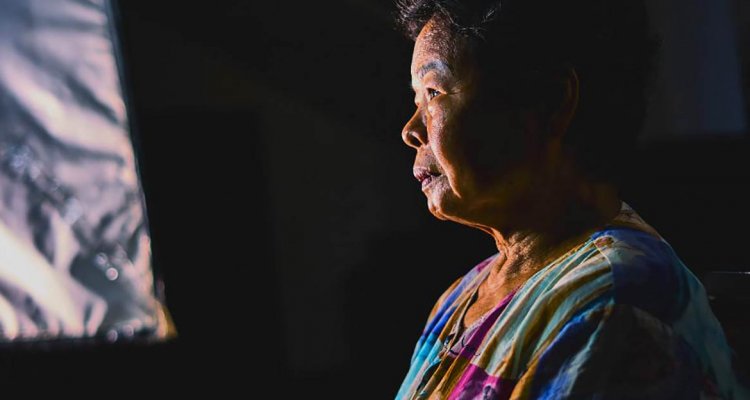Picasso began his portrait of the poet Gertrude Stein in the autumn of 1905, completing it in August the following year. Delay was down to the head. For someone of Stein’s stature and charisma, a truly mimetic depiction couldn’t suffice. Picasso’s visit to the Louvre saved the portrait. The Iberian stone masks in exhibition inspired the stylised imagery of Stein’s face, allowing the browns and oranges of her clothing to blend with the background, in which the body seems at home, in place. As rendered by Picasso, her face is a concrete fortification, behind which interiority is sacrificed.
More than a century on, this aesthetic of hard surfaces — of distance through proximity — is alive in “Your Face,” the latest documentary (posing as art installation) from revered Taiwanese filmmaker Tsai Ming-liang. His most recent work, virtual reality effort “The Deserted,” didn’t allow for invasive close up. ‘Your Face’ contains little else. Contrast is the spice of life.
In just over an hour Ming-liang presents 13 faces, all illustrating degrees, and states of aging. These faces have pockmarks, wrinkles, sun spots, warts, sparse stubble, sagging jowls, eyelids inflated in repose. Yet they mostly retain health and vigor. Each participant — taken mostly from the streets of Taipei — is apparently without instruction, as subliminal forces coax response: to stare straight, to remain silent, to recounts memories, to expose ambitions. Some resist speech; some embrace it. The viewer is encouraged into sensitivity towards movement, detail, utterance. Perhaps there is a cheap profundity to this.
Subjects are framed as if in eulogy, but Ming-liang’s earnest direction (or lack thereof) produces a complex picture of subsistence and sorrow. These people are open and closed, forthcoming and withdrawn. Close-ups both enable and foreclose readings of internal psychology. The mind isn’t privileged as a unit of understanding but treated as another surface, one equivalent to an object, a background, a body, a face. Just as Stein’s famed ‘flat’ mask retains proportion in the nose and brow, Ming-liang’s pedantically lit portraits reveal facture, such that overwhelms the desire to exhibit human memory underneath.
The first subject, a woman with darting, uncomfortable expression, stays mostly mute. She mutters midway that the process of being seen, of being ogled by a camera, ‘is strange and disturbing.’ It’s a useful statement of intent. The next woman, viewed from the side, enters into disclosure. She clucks her tongue, shifts her head, implies further exercises. These movements are necessary in old age as acts of preservation, of endurance. One man falls into sleep, morphing into an Easter Island head, only to awake with blissful assertiveness.
Ming-liang prompts one woman, her life defined by beauty and relentless graft, to rationalize her failed marriage. His prodding jars and reveals the filmmaker underneath: this work isn’t simply an isolated art object. Another man delves deep into his past gambling habits — Pachinko, the curse — indicating regrets of youth that topple onwards. The last participant, Ming-liang’s long-time collaborator Lee Kang-sheng, ruminates on his childhood, on his failure to learn English and to obey his father. Even in testimony, the interior is hidden, the experience opaque. This is despite the immediate fact: that we are near, that we are lucid, that we can see these faces and hear those words.
Much can be made of the film’s minimalism, leading to accusations of pretentiousness and difficulty. The brevity and coherence of “‘Your Face” supersede some of these concerns. Often averse to music, Ming-liang makes sparing use of Ryuichi Sakamoto’s droning impressions, these spontaneous rather didactic. Bells and chimes are elements of composition rather than tools to interrogate thought process. Beliefs, regrets, desire: all must take turns with the sound, the face, the body, the environment. This artistic method requires repetition and an extensive sample. Stein’s head, produced via exhaustive alterations, is founded on a similar wish to move from identity to entity, to reform the Cartesian dualism of matter and mind, of material and feeling.
In this way, “Your Face” is concerned with the superficial, with the mysteries of the visible. Through this thesis it sets its portraits, fixing the face, cinematically, in time. The final persisting shot of an empty ballroom halts the procession of heads. Light and sound alter the scene, producing an accumulative conclusion, one that values setting equally to those who populate it. If the ballroom has permanence, so has the face. If the portrait is subverted, so is history. Ming-liang asks us to consider how we see, record and remember, how these processes in art and cinema shape our beliefs about inner lives, past and present. Picasso also knew the power portraiture could hold on history. Informed that Stein looked nothing like his rendering, he replied simply — “She will.” [B+]

